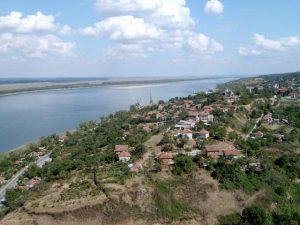

The monastery was founded in the year 1544. The studies show the fact that it never was a known workshop of watercrafts. The monastery’s history can be followed from the Thracians, which left traces in numerous caves from the surroundings. In the proximity of the monastery is the crown of gold of the foundations of which there springs a Karstic fountain, and on the western wall there are conserved the remains of the fresco. The monastery is situated in the proximity of Bistrets Vrața.
The monastery’s history:
Information about the early existence of the monastery Bitretskiya are found in the rock inscriptions from above the monastery itself. They talk about is foundation or about the restoration of the monastery in 1540, by Dimităr Dubov. Above the inscription there were painted three scenes from the life of Saint Dimitrie and two from the life of Saint Gheorghe. Even in the rock there is spirit, in the case in which the legend talks about the fact that here lived Ivan Rilski, according to whose name it was named later on the monastery. In the 18th – 19th century, the walls of the skete were covered with mural paintings dedicated to saint Rila, which are now seriously damaged. Later on, it was built the church “Saint John the Evangelist”, in which there are two layers of frescos from the 16th – 17th centuries and from the 19th century. The altar is sculpted in wood, from 1820, and the citizen Tryavna Petru Minyov painted the icons.
Between the 17th and 19th centuries, the monastery played an important role in the cultural development of the region. Here functioned a school and worked important writers, such as Joseph Bărbosul and Todor Vratsa. The monastery was the workshop of the gold handicraftsmen of the famous sculpted cross, executed in 1611 by the masters from Chiprovtzi Nicolae and Pala. In 1822, in the monastery Bistretskiyat there was a refuge for the rebels and, consequently, it was destroyed twice, but later on it was rebuilt. The last renovation of the monastery was in 1867, during the times of the monk Yoasaf. Between 1894 and 1928 the monastery was abandoned by the monks and since then it is called “empty” until 1928, when it is lightened with a new name – “Saint Ivan Rilski”.
The architecture and the current state:
In our days, the monastery Bistretskiyat is operational, and our visitors can even see a monastic presence. Currently, the location of the monastery existed even in the 19th century. In the former complex of the monastery is the best well conserved church “Saint John the Evangelist” which dates back to the 16th century. It is a building with a nave, apses, with a chapel on a high cylindrical support. In the church there exist two layers of frescos. The first are from the 16th – the 17th century. In an alcove it is kept the “Pieta” and the image of Saint Steven, and on the apses of the altar there are the scenes “the Community of the apostles” and the “Adoration of the victim”. On the wall from the western entrance it is found the composition the “Last Judgment” painted in 1867 during the times of the monk Yoasaf. It is also conserved the iconostasis sculpted from wood executed in 1820 by the master Peter Minyov from Tryavna. The same artist is the author of some of the icons from the temple. At approximately 15 km. from the Monastery Bistretskiya it is found the cave “Ledenika”, which is one of the 100 national tourist places of the Bulgarian Tourism Union.

